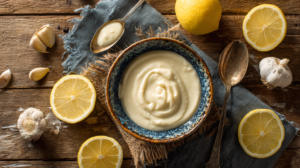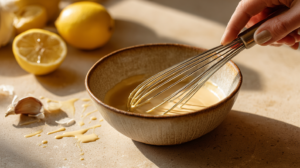Want to take your dishes to the next level? This creamy homemade tahini sauce is your go-to condiment! Whether you’re dressing a fresh salad, drizzling over roasted veggies, or serving it with falafel and pita, this tangy sesame-based sauce is packed with flavor and ridiculously easy to make at home.
Table of Contents
What Is Tahini Sauce?
Tahini sauce is a traditional Middle Eastern condiment made from ground sesame seeds (tahini), lemon juice, garlic, and water. It’s naturally vegan, rich in healthy fats, and adds a nutty, tangy flavor to countless recipes. What makes this version so special? It’s silky smooth, perfectly balanced in taste, and requires just a whisk to make—no blender necessary!

What Is Tahini Sauce?
Why This Tahini Sauce Is the Best
This isn’t your average tahini sauce. Here’s why this version is next level:
-
Ultra creamy texture
-
Mellow garlic flavor
-
Perfectly balanced tang from fresh lemon juice
-
Ready in just 20 minutes
-
Customizable with fresh herbs or spices
Whether you’re new to tahini or a longtime fan, this recipe is going to change the way you think about this classic sauce.
Ingredients You’ll Need
To make this delicious tahini sauce, gather the following ingredients:
-
4 large garlic cloves (minced or pressed)
-
¼ cup fresh lemon juice
-
½ cup tahini (preferably Ethiopian-sourced)
-
½ teaspoon fine sea salt
-
Pinch of ground cumin (optional, but recommended)
-
6 tablespoons ice-cold water (plus more to adjust consistency)
Step-by-Step Instructions
Step 1: Infuse the Garlic
Mix the minced garlic with lemon juice and let it rest for 10 minutes. This infuses the juice with a subtle garlic flavor and reduces harshness.
Step 2: Strain the Garlic
Pour the mixture through a fine mesh sieve. Press down to extract all the flavor and discard the solids. This ensures a smooth texture.
Quick Tip: Short on time? You can skip the garlic step altogether and mix lemon juice directly in the next step.
Step 3: Whisk in Tahini, Salt, and Cumin
Add tahini, salt, and cumin to the lemon mixture and whisk. It might thicken or seize initially, but don’t panic—this is normal.
Step 4: Add Ice-Cold Water Gradually
Slowly add water 2 tablespoons at a time, whisking continuously. The mixture will loosen and transform into a creamy, light-colored sauce.
Step 5: Adjust to Taste
Taste your sauce and tweak:
-
More water = thinner sauce
-
Extra lemon = more tang
-
More salt = deeper flavor
Optional Variations
-
Herbed Tahini Sauce: Add finely chopped parsley, cilantro, basil, or dill for a fresh twist.
-
Spicy Kick: Mix in a pinch of cayenne or chili flakes.
-
Green Tahini Sauce: Blend the sauce with herbs for a uniform green color and stronger herbal flavor.

Step-by-Step Instructions
Serving Suggestions
This versatile sauce pairs beautifully with:
-
Crispy falafel
-
Grilled or roasted vegetables (like cauliflower or carrots)
-
Buddha bowls and grain salads
-
Wraps, pitas, and flatbreads
-
As a salad dressing (just thin with a bit more water)
-
As a dip alongside hummus or baba ganoush

Serving Suggestions
What’s the Best Tahini to Use?
For the best results, choose tahini made from Ethiopian sesame seeds. Highly recommended brands include:
-
Soom Foods Tahini (available online)
-
Trader Joe’s Organic Tahini
-
Baron’s or Al Arz Tahini (available at Middle Eastern grocery stores)
Avoid overly bitter or thick tahini pastes.
How to Store Tahini Sauce
-
Refrigerator: Store in an airtight container for up to 1 week. It may thicken over time; simply whisk in a splash of water to thin.
-
Freezer: Freeze for up to 1 month. Thaw overnight in the fridge and stir well before using.
Nutrition Information (Per Serving)
| Nutrient | Amount |
|---|---|
| Calories | 120 |
| Fat | 11g |
| Saturated Fat | 1.5g |
| Sodium | 140mg |
| Carbohydrates | 4g |
| Fiber | 1g |
| Protein | 3g |
Note: Nutrition values are approximate and based on 1 of 6 servings.
Pro Tip: Make It in a Food Processor
If you’re doubling the recipe or want to blend in herbs, a food processor is a great option:
-
Toss unpeeled garlic in and pulse.
-
Add lemon juice and rest for 10 mins.
-
Strain garlic, return juice, then add tahini, herbs, salt, and cumin.
-
Blend until smooth, adding water gradually.

Make It in a Food Processor
Final Thoughts
Once you try this homemade tahini sauce, store-bought versions just won’t compare. It’s creamy, flavorful, and enhances just about everything you pair it with. Whether you stick to the classic or try herbed or spicy variations, this sauce deserves a spot in your weekly meal rotation.
Frequently Asked Questions
Q: Can I use bottled lemon juice?
Fresh lemon juice is best, but bottled works in a pinch.
Q: Can I skip the garlic?
Yes! You can omit it or follow the shortcut version in the instructions.
Q: Why is my tahini sauce bitter?
Poor-quality tahini can be overly bitter. Choose tahini made from Ethiopian sesame seeds.

